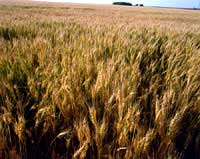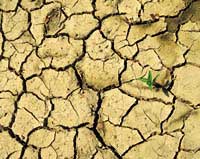Droughts in the United States, Ethiopia, and Afghanistan have been big news this year — and even more serious water shortages are emerging as the demand for water in many areas of the world simply outruns the supply. Water tables are now falling on every continent. Literally scores of countries are facing water shortages.

All cracked up.
We live in a water-challenged world, one that is becoming more so each year as 80 million additional people stake their claims to the Earth’s water resources. Unfortunately, nearly all the 3 billion people projected to be added to the planet over the next half century will be born in countries that are already experiencing water shortages. Even now many in these countries lack enough water to drink, satisfy hygienic needs, and produce food.
Even with today’s 6 billion people, the world has a huge water deficit. Using data on overpumping in China, India, Saudi Arabia, North Africa, and the United States, Sandra Postel, author of Pillar of Sand: Can the Irrigation Miracle Last?, calculates the annual depletion of aquifers at 160 billion cubic meters or 160 billion tons. Overpumping is a new phenomenon, largely confined to the last half century. Only since the development of powerful diesel and electric pumps have we had the capacity to pull water out of aquifers faster than it is replaced by precipitation.

Fielding questions.
NREL/PIX.
Using the rule of thumb that it takes 1,000 tons of water to produce one ton of grain, our 160 billion-ton water deficit is equivalent to 160 million tons of grain, or one half the U.S. grain harvest. Considering that average world grain consumption is just over 300 kilograms or one third of a ton per person per year, 480 million of the world’s 6 billion people are essentially being fed by grain produced with the unsustainable use of water.
In addition to population growth, urbanization and industrialization also expand the demand for water. As developing country villagers, traditionally reliant on the village well, move to urban high-rise apartment buildings with indoor plumbing, their residential water use can easily triple.
Some 70 percent of the water consumed worldwide, including both water diverted from rivers and water pumped from underground, is used for irrigation, while some 20 percent is used by industry, and 10 percent for residential purposes. In the increasingly intense competition for water among sectors, agriculture almost always loses. The 1,000 tons of water used in India to produce one ton of wheat worth perhaps $200 could also be used to expand industrial output by $10,000, or 50 times as much. This ratio helps explain why, in the American West, the sale of irrigation water rights by farmers to cities is an almost daily occurrence.
More Than Meats the Eye
Rising affluence in itself generates additional demand for water. Wealthier people tend to eat higher on the food chain, and as they consume more beef, pork, poultry, eggs, and dairy products, they use more grain. A U.S. diet rich in livestock products requires 800 kilograms of grain per person per year, whereas diets in India, dominated by a starchy food staple such as rice, typically need only 200 kilograms.

Sitting on sacks of grain in the Middle East.
Photo: P. Sudhakaran, U.N. Photos.
Once a localized phenomenon, water scarcity is now crossing national borders via the international grain trade. The world’s fastest growing grain import market is North Africa and the Middle East, stretching from Morocco to Egypt to Iran. Virtually every country in this region is simultaneously experiencing water shortages and rapid population growth.
As the demand for water in the region’s cities and industries increases, it is typically satisfied by diverting water from irrigation. The loss in food production capacity is then offset by importing grain from abroad. Since one ton of grain represents 1,000 tons of water, this becomes the most efficient way to import water.
Last year, Iran imported 7 million tons of wheat, eclipsing Japan to become the world’s leading wheat importer. This year, Egypt is also projected to move ahead of Japan. Iran and Egypt have nearly 70 million people each. Both populations are increasing by more than a million a year and both are pressing against the limits of their water supplies.
The water required to produce the grain and other foodstuffs imported into North Africa and the Middle East last year was roughly equal to the annual flow of the Nile River. Stated otherwise, the fast-growing water deficit of this region is equal to another Nile flowing into the region in the form of imported grain.
It is now often said that future wars in the Middle East will more likely be fought over water than oil. But perhaps the competition will actually take place in world grain markets. The countries that will “win” will be those that are financially strongest, not those that are militarily strongest.
Keeping Our Heads Above Water
The world water deficit grows larger with each year, making it potentially more difficult to manage. If we decided abruptly to stabilize water tables everywhere by simply pumping less water, the world grain harvest would fall by some 160 million tons, or 8 percent, and grain prices would go off the top of the chart. If the deficit continues to widen, the eventual adjustment will be even greater.
The risk is that the growing number of water-short countries with rising grain import needs, including population giants China and India, will overwhelm the exportable supply in food surplus countries, such as the United States, Canada, and Australia. This in turn could destabilize world grain markets.
Although there are still some opportunities for developing new water resources, restoring the balance between water use and sustainable supply will depend primarily on demand-side initiatives, such as stabilizing population and raising water productivity.
Governments can no longer separate population policy from the supply of water. And just as the world turned to raising land productivity a half century ago, so it must now turn to raising water productivity. The first step toward this goal is to eliminate the water subsidies that foster inefficiency. The second step is to raise the price of water to reflect its true cost. Shifting to more water-efficient technologies, crops, and forms of animal protein offer a huge potential for raising water productivity. These shifts will move faster if the price of water more closely reflects its value.
If we delay dealing with our water deficit, we risk water shortages becoming food shortages. Some low-income, water-short countries may not be able to afford to import needed grain, and millions of their citizens may be left hungry and thirsty.



